Sigma fp L Camera Review: Photographer’s Point of View
A while back, Sigma released their first L mount camera, which was the fp. I reviewed it (review here), and thought it had a lot to offer, especially it being so compact. Recently, Sigma released another model: the fp L. There are some changes but one main difference is that the fp L comes with a 61 megapixel sensor. Being that I’m an L mount user, and I just love cool gear in general, I knew I had to get my hands on this just to see what it was all about. Before I begin, I know that in addition to photography, this camera is also marketed towards videographers. Keep in mind that this review is primarily through a photographer’s perspective. Here’s what I think of it.
Sigma fp L Camera Build Quality:
So, let’s talk about the overall build first, and in terms of this, the Sigma fp L is very impressive. The body feels very solid and dense, thanks in part to it being made of die-cast aluminum, which is both tough and lightweight. With a total of 42 points of sealing, the fp L is dust and splash resistant. It also has a large magnesium heat sink that prevents overheating. With these features, the fp L is not only very capable of handling less an ideal weather, it can handle being used for hours and hours as well. Overall, the fp L is a tough little camera that feels like a high quality product.

↑ The Sigma fp L with the 28-70mm f2.8 DG DN Contemporary lens.
Let’s jump into the ergonomics now. As you can see in the photos, the Sigma fp L isn’t your typical camera when it comes to overall design. It’s different; it’s a bit quirky, and in a way, I feel like that’s always been one of Sigma’s traits with cameras. They’ve always produced cameras that were different from the rest of the pack. They’ve always seem to take more chances with their designs versus their competitors. With that said, the fp L is a very attractive looking camera in my opinion.

↑ Top plate of the fp L.
Plus, I didn’t find it as uncomfortable to hold as one might think. It’s definitely different because it doesn’t have a grip like most typical cameras do these days. But it is actually decent with smaller lenses like say Sigma’s I Series, for example. If you are finding that you’re using larger lenses all the time or you might need a little more support, there are two hand grips you can purchase. There is the HG-21 Large Hand Grip, which mounts to the baseplate of the camera or the the smaller HG-11 Hand Grip that just mounts to the side of the fp L. I had the smaller one with my review sample, and I think if I were to purchase a grip for the fp L, I’d probably just go with this one. It doesn’t make the fp L as large as the HG-21 would yet it still offered me enough support for what I would do with the camera.

↑ The Sigma fp L with the HG-11 Hand Grip.

↑ Here’s how the HG-11 Hand Grip looks like on the side.
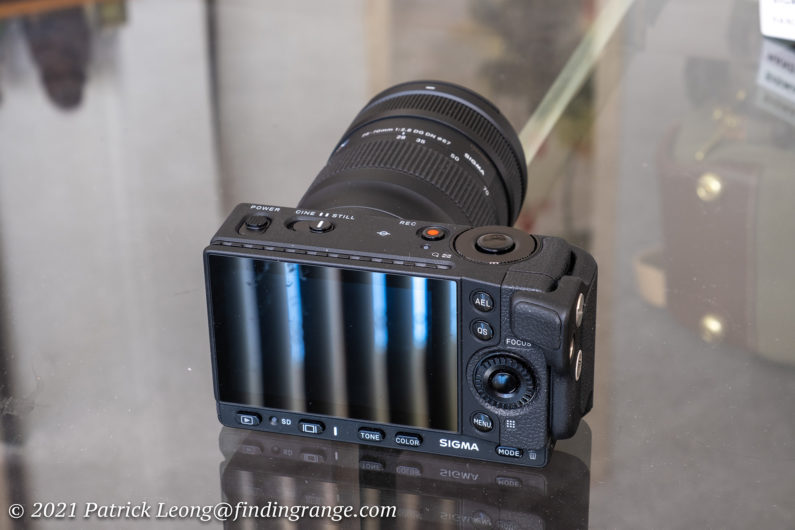
↑ Here’s the rear view of the HG-11 Hand Grip.
Continuing with ergonomics, the placement of buttons and wheels around the body of the Sigma fp L are pretty logical. That’s not easy to do, especially when the camera is so compact, and therefore, there’s just less real estate to work with, so I definitely give Sigma credit here. I did find some of the buttons to be a little light to the touch though. The wheel in the back was a little sensitive, for example. With that said, this is a minimalist design, which means that there aren’t a ton of buttons on the back, which I really like. Everything is very easy to figure out, and this goes with the menu system as well.
Either the overall ergonomics are something you are okay with or are not but either way, there’s no denying how compact the fp L is, especially for a full frame camera with 61 megapixels. The dimensions are the same as the fp’s, which are 112.6 x 69.9 x 45.3 mm / 4.4 x 2.8 x 1.8 in with the fp L weighing in at just 375 g / 13.2 oz. That is just 5 g heavier than the fp. It’s worth noting that both fp cameras are still the world’s smallest full frame cameras.
Just imagine the possibilities with something like the Sigma fp L (B&H Photo/Amazon). You have something that is full frame with an insane amount of pixels that essentially will fit in your pocket. You can hike all day long to get the perfect landscape shot or walk around the city to look for that stunning cityscape photo. If you have M lenses, you can walk around discreetly shooting street photography with ease. So yes, there are some sacrifices in terms of the ergonomics, which is a given considering how Sigma has shrunk this camera down but there are also huge gains, in my opinion, as well from having something with this much power and potential in such a compact form. This is a camera that is cut down to the essentials, and in that way, it kind of reminds me of the Leica M.
As for features, there are still quite a few that are noteworthy. For one, fp L does have an excellent 3.15″ 2.1m-dot touchscreen LCD. It’s a great display that is not only sharp but bright and vibrant as well. For the sake of being compact, there is no built in viewfinder. However, you can purchase the EVF-11 Electronic Viewfinder, which attaches to the side of the body.

↑ Here’s the LCD display.
The EVF is a little quirky but very functional. It does make the camera noticeably larger, and it does attract more attention. Plus, I wish it had eye detection instead of a switch, so that it can automatically turn the evf off, and switch to LCD mode the moment I take the camera away from my eye but it’s a 3.68m-Dot OLED EVF with a large 0.83x magnification, so it’s great to view through. It’s nice, clear and sharp. That large magnification is great. It also has a 90º upward tilting design, which I love. Tilting it around really makes things easier, and it’s great to have eye-level monitoring. I think this does help partially make up for a lack of a tilting display, which I’m sure some would want.

↑ Here’s the EVF-11 Electronic Viewfinder.
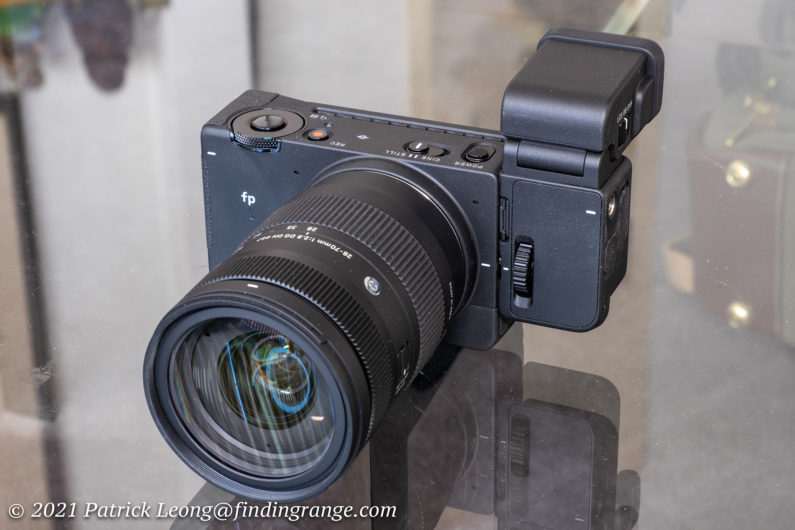
↑ Here’s the EVF-11 attached to the fp L.
The fp L also has a full time electronic shutter. There are definite positives to an electronic shutter, such as, no shutter shock, no shutter sound, and no shutter lag. It has also helped make the camera smaller. Plus, with fewer moving parts, the camera is technically more reliable. But the downside is you may experience occasional flickering when you’re shooting in an area with fluorescent lighting, for example. I did experience that very occasionally but for the most part, at least for what I shoot, it wasn’t much of an issue.
The other downside is that since it’s an electronic shutter, the read out speed is slower, so it can distort or skew moving objects. Again, for what I shot, I didn’t have a problem, so I guess it would really depend on your subject matter. But just so you know, I shot with the fp L quite a bit because in addition to reviewing the camera, I was also reviewing three additional Sigma lenses with it. It meant I needed a ton of content, and I was always out shooting with the fp L. I did street photography, landscape, cityscape, general photography, and I even took the fp L along with me on a couple of my model shoots. I had moving people, moving bikes, etc. in some of my photos. I shot the fp L the way that I normally would shoot any camera, and at least for me, I didn’t run into any issue.
As for image stabilization, there’s no in-body but there is EIS (electronic image stabilization), which will also crop the image a bit. It would be nice to have in-body image stabilization but it would also increase the body size of the camera.
In terms of a power source, the Sigma fp L uses a battery that will give you a charge that is good for approximately 240 shots. The fp L also supports USB charging while the camera is on, so you can technically shoot without interruption. You can even do this outdoors where you might not have a power outlet because you can use a power bank (portable battery charger). If you use the fp L as a webcam (which you simply do by plugging it into a computer via USB-C), it’ll get its power supply from the computer.
As for video, the fp L maintains the same performance from the fp. It can record 8-bit CinemaDNG files to an SD card, and 12-bit 4K at 29.97 fps CinemaDNG over USB-C. Both have a max recording time of two hours. The fp L also supports Blackmagic RAW and ProRes RAW over HDMI recording as well.
Sigma fp L Camera Autofocus:
The autofocus has also been improved over the fp. The Sigma fp L (B&H Photo/Amazon) uses a hybrid autofocus system that combines phase detection and contrast detection instead of the fp’s contrast detection based system. This focusing system is suppose to be accurate down to -5 EV, and has 42 selectable points that can be changed by the touchscreen display.
From what I experienced, the autofocus is good overall. It’s snappy, it’s capable, and quick enough for stills photography. At the time I was reviewing the fp L, I had multiple Sigma lenses with it, which were all being reviewed, and they worked with the fp L very nicely.
I took the fp L and the lenses around the city, and did everything from street photography to cityscape. I went down to Atlantic City in New Jersey for a night just to change it up a bit. Overall, the autofocus didn’t cause me any real issues. The face and eye detection did a great job as well at tracking my subjects. I did take the fp L with me on a couple of my shoots, and it’s plenty capable of taking sharp photos as my model was changing her poses. I think if you’re shooting a lot of action or sports photography, that’s where the autofocus system will struggle a bit.
Sigma fp L Camera Image Quality:
I think the best feature of the Sigma fp L, to me at least, is probably the image quality. As I mentioned earlier, the fp L has a 61 megapixel back-illuminated Bayer CMOS sensor, and what it produces is simply phenomenal. What I love the most about this is you’re getting all of this in such a compact form. The tonality, the accurate color rendering, and just the crazy amount of megapixels are a pleasure to work with and use. Images also have this really nice smoothness to them, if that makes sense.

↑ This was taken somewhere in Chinatown using 1600 ISO and the 52.3mm (24-70mm f2.8 DG DN Art) focal length. I also used f5.6.

↑ This was taken somewhere in Chinatown using the fp L, and the 70mm focal length. The settings were 200 ISO and f8 (28-70mm f2.8 DG DN Contemporary).
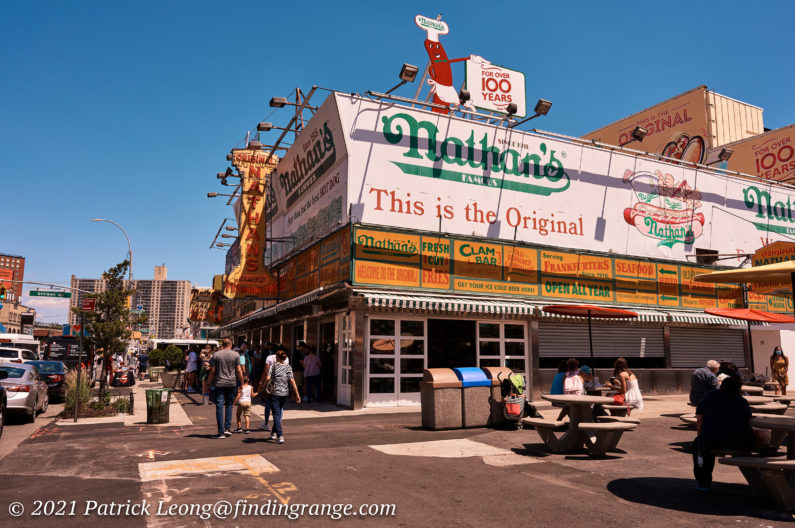
↑ This was the first time I was back at Nathan’s in Coney Island since Covid hit but I didn’t get anything because the lines were way too long haha. I used the fp L and the settings were 160 ISO, f8, and the 28mm focal length (28-70mm f2.8 DG DN Contemporary).

↑ This was taken on a very hot day (actually, all the days have been very hot and humid it feels like) using the 28.6mm focal length from the 24-70mm f2.8 DG DN Art and f8. I used 500 ISO as well.
The sensor does have a low-pass filter, which was a choice made by Sigma, and makes sense for video but if you didn’t tell me it had one, I wouldn’t know it because the detail that this sensor picks up is quite high. As I said before, I was testing the fp L with several Sigma lenses, and I was extremely impressed with the detail that this camera was resolving. The Sigma fp L (B&H Photo/Amazon) would probably make an excellent camera for someone who is into landscape or cityscape photography with just the sheer detail that it can retrieve along with the massive amount of megapixels as well, which I have to say, I loved having.

↑ This was shot out of a very dirty window. I had to take several shots because I kept getting smudges from the window. The setting here were 200 ISO, and f7.1. The focal length used was 60.8mm from the 24-70mm f2.8 DG DN Art.

↑ Here’s another photo taken at f8 with the 28mm focal length. 640 ISO was used along with the Sigma fp L here as well (28-70mm f2.8 DG DN Contemporary).

↑ This was taken around Chinatown with the settings being f5.6 and 100 ISO. I used the 35mm f1.4 DG DN Art.

↑ Here’s a photo taken with the fp L, and the focal length was 28mm. I used 125 ISO and f8 (28-70mm f2.8 DG DN Contemporary).
Speaking of megapixels, since you have so many, it can handle more extreme cropping as we know. This leads me to Sigma’s cropped zoom feature that works in both the STILL and CINE modes. Since there’s 61 megapixels, the fp L can record in full HD quality even at its maximum 5x zoom that is accomplished simply by cropping with no digital enhancement. You can even pinch to zoom on the LCD touch screen.

↑ This photo was originally taken in the portrait orientation but I didn’t like it. So, with 61 megapixels, I did a horizontal crop of the photo just to see what I would get. I still had over 24 megapixels. I normally refrain from cropping but I thought the shirt and shoes on this woman would look good in black and white, and I just preferred the scene this way. The settings are f5.6 and 400 ISO. I used the 35mm f1.4 DG DN Art.

↑ Here’s another photo taken with the 35mm f1.4 DG DN Art at f5.6 with me using 320 ISO.

↑ I barely had time to frame this before the person on the moped drove away. The autofocus was quick enough to capture it using the 35mm f1.4 DG DN Art. The settings were f8 and 100 ISO.
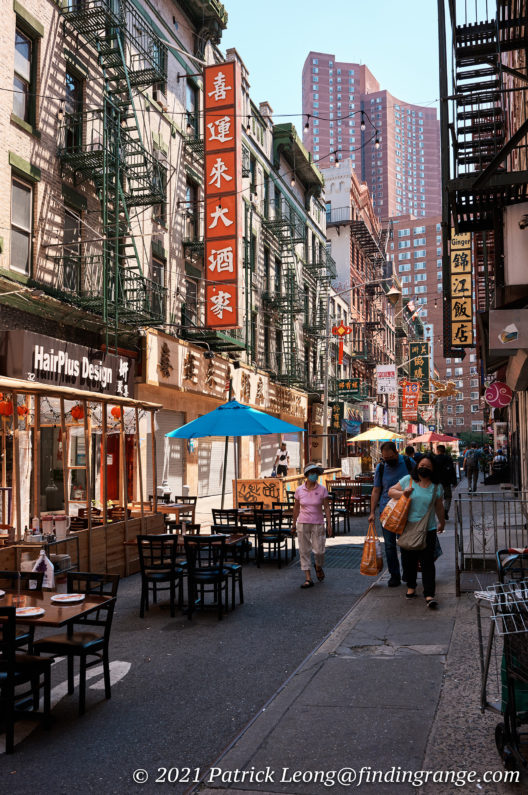
↑ This photo was taken around Chinatown using f8 and 500 ISO. The lens of choice was the 35mm f1.4 DG DN Art.
It’s also worth noting that the dynamic range of this sensor is just superb. I don’t do any scientific testing but I imagine that if it’s not the top in its class, it has to be at least up there with the best. Bringing the RAW files back into Capture One, I was just so please with how much detail I could recover from highlights and shadow areas. Even in situations where contrast is very strong, areas in the image can be quite recoverable.

↑ I fudged badly in this photo but it is actually a great example of how much detail you can recover back. I shot it really quickly but forgot I had it on 12800 ISO from the other night, and this was during a bright summer day. So naturally, it’s way overexposed but check out the detail I was able to recover below and at 12800 ISO.

↑ So, luckily I shoot in RAW. This was processed in Capture One. The lens used was the 28-70mm f2.8 DG DN Contemporary set at f4 and the 28mm focal length.

↑ Here’s a 100% crop of the photo above.

↑ I was at Atlantic City one night, and took this photo. It was taken with the 52.7mm focal length using f4 from the 24-70mm f2.8 DG DN Art. I used 100 ISO.

↑ Here’s a photo taken at f2.8 using the 70mm focal length from the 24-70mm f2.8 DG DN Art.

↑ Here’s one taken with the 70mm focal length. The settings were 100 ISO and f8 (24-70mm f2.8 DG DN Art).
Furthermore, I found the high ISO capabilities of the Sigma fp L (B&H Photo/Amazon) to be impressive as well. You begin to see slight grain at 1600 ISO but it’s absolutely nothing to worry about, and the detail retrieval is still excellent. In fact, while noise does increase as you increase ISO, I still found the files produced up to 6400 ISO yield superb results overall. Even at 12800 ISO, you can get excellent results considering the setting. At 25600 ISO, noise and color saturation are more effected but if you zoom in, there is still decent detail. The point is, you can still use these two ISO settings, and get good keepers.
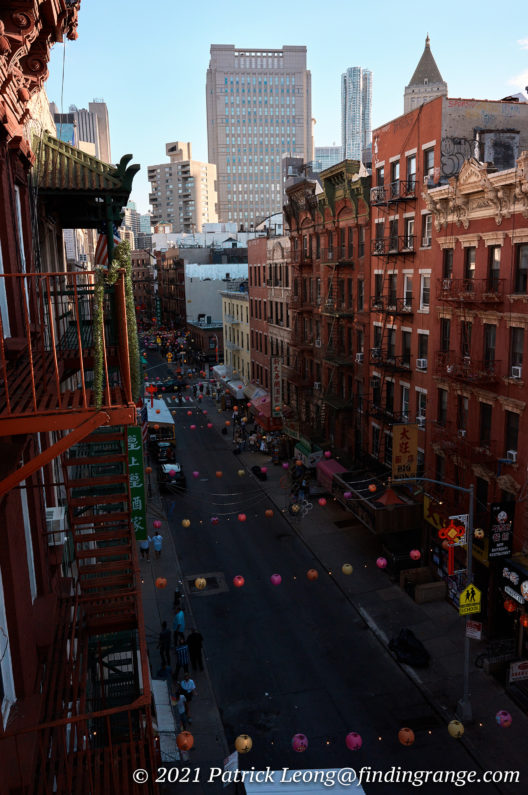
↑ This was taken with the 28-70mm f2.8 DG DN Contemporary using the 28mm focal length and f8. This was taken at 3200 ISO.

↑ Here’s a 100% crop of the photo above.

↑ Here’s another photo taken with the 28-70mm f2.8 DG DN Contemporary using the 28mm focal length and f5.6. I used 6400 ISO.

↑ Here’s a 100% crop of the photo above.

↑ This was taken with the 28-70mm f2.8 DG DN Contemporary using the 70mm focal length and f5.6. I used 12800 ISO here.

↑ Here’s a 100% crop of the photo above.

↑ Here’s one more taken with the 28-70mm f2.8 DG DN Contemporary using 25600 ISO and f5.6. I used the 34.1mm focal length.

↑ Here’s a 100% crop of the photo above.
Pros And Cons:
Pros:
- Solidly built.
- Weather resistant.
- Extremely compact, especially when you consider it’s full frame.
- A lot of accessories to customize the camera to your needs.
- Great video
- Stunning image quality.
- Part of the L Mount Alliance, which means access to not only Sigma but Leica and Panasonic lenses as well.
Cons:
- Ergonomics won’t be for everyone.
- Lack of mechanical shutter.
- No tilting/rotating display.
- A ton of great accessories but they will add up in cost.
Sigma fp L Camera Verdict:
The Sigma fp L is a unique camera that is a bit quirky but I look at it as character, and in the right hands, there is a ton of potential. It is definitely different than what is typically out there in the camera world these days, and I think Sigma deserves a lot of credit for being brave enough to try something that is just out of what we typically feel is or should be the norm.

↑ Yellow sign and yellow Beetle. This was taken with the 36mm focal length and 1000 ISO. I used f8 (28-70mm f2.8 DG DN Contemporary).

↑ This was taken using the 57.9mm focal length from the 24-70mm f2.8 DG DN Art. The settings were f11 and 500 ISO. I was walking around the Lower East Side at the time.
With that said, like every other camera out there, it’s not perfect. There were some sacrifices made to make such a compact full frame camera. For one, the ergonomics might not be for everyone, and for some, having only an electronic shutter might be an issue.

↑ This was taken with 100 ISO and f4. The focal length I used was 46.1mm (24-70mm f2.8 DG DN Art).

↑ This was taken in Chinatown using the 43.6mm focal length, and 125 ISO. f8 was used, and it was converted to black and white in Capture One (24-70mm f2.8 DG DN Art).
However, I like to look at the big picture, and there are quite a few traits going for it as well. For one, the fp L could be considered pocket size yet it has a 61 megapixel full frame sensor that produces downright stunning images. While maybe not a camera designed for sports photography, I can definitely see someone using it for general, cityscape, landscape, portraiture, and street photography. Just imagine how easy it would be to hike in the woods with this camera or walk around streets getting shots all day. For Leica users looking for a second body, imagine attaching a compact M lens to it like a 35mm Summicron, and going around doing street photography. You can do all of this with something that will produce reference level images with its insane 61 megapixel sensor. Plus, it’s L mount, which means you have access to not only Sigma but also Panasonic and Leica L mount lenses.

↑ This photo was taken using the 34.3mm focal length. The settings were 250 ISO and f4 (28-70mm f2.8 DG DN Contemporary).

↑ Here’s a photo taken at f8 with 160 ISO. The focal length used was 49.1mm from the 28-70mm f2.8 DG DN Contemporary.
Overall, the fp L is definitely different from the rest of the pack, and comes with its own quirks. However, in the right hands, it would make a great camera to use and own.
Thanks for taking the time to read my review! If you’re considering purchasing the Sigma fp L, and my review helped you decide, please help support this site by purchasing from the links below or any mentioned in this review. It will not cost you anything extra. Thank you for your support!


The fp had an great feature for m mount glass where you could register a lens on the camera after taking a test picture where it would correct for cyan shift. Hence, you can correct Leica lenses without the 6 bitcode as well as non Leica glass – brilliant. I have never seen a review mention this valuable feature. I assume the fp l does this as well
Good question; I guess I will find out when I get another loaner again :). I plan to get another loaner to use it exclusively with M lenses, and write up an entire article for it. I think there’s huge potential for the fp L as an M mount camera. It’s small, and light making it great for street. Plus, it packs a 61 MP sensor :).
Obviously, it can also be used to fix Leica coded lenses but I was trying to point out that, unlike Leica, it can correct all glass. This is brilliant. It does not correct for vignetting but I often prefer corners darkened and also manually correct vignette if necessary.
Vignetting is also easy to correct, if one want to anyway. But like you, I also prefer the darker corners :).
I am thinking about the fp L as a compact camera to go with my SL2.
Hi Brian,
I am so sorry for the late reply. My summer has been very busy!
I think it would make a great camera to accompany the SL2. It’s so small yet it packs such a big punch, AND it uses the same lenses as the SL2 :)! Let me know if you have any questions. Always great to hear from you, Brian!
Best,
Patrick
Hello Patrick,
thanks for yet another great review. While i dont dig the physical appearance of the camera i am definelty a fan of the iq. Having said that, all images seem to be on the warm side of neutral (or there is something wrong with my second monitor). Is this due to pp or a character of the lens/sensor combination ? Or am i wrong ?
I would be interested to see how the camera performs with Leica lenses. Would have been great to hear what you think about that. The Hasselblad also only has an electronic shutter (in camera) and while you can get good results with M lenses it is less than ideal (you easily get banding).
Love the images as well (gear undependant). Always nice to see life in NYC.
Oh and there is a shop that just sells saucages (Frankfurter of course) that exists for more than 100 years ? wow. That would not be possible here in Frankfurt (Germany) – lol.
greetings Markus
Hi Markus,
Thanks for taking the time to read it!
The warmer colors might be me, and plus, I was taking it out on summer days that had a warmer tone.
I may get another loaner just to test it with Leica M lenses. I’ve been wanting to try it for a long time. I just didn’t have enough time to try it with this loaner only because I was also reviewing three Sigma lenses with it, and wanted to give those lenses a good testing. As for banding, it can be an issue but for everything I shot, it didn’t occur. I only ran into two occasions where I did get banding but those photos were mistakenly snapped anyway as I was walking haha.
Thanks for the kind words about my images. I haven’t done as much shooting around the city as I would like for a long time but I hope to change that soon. I’m just waiting for the weather to cool down a bit haha.
That shop is Nathan’s :). It’s in Coney Island, and probably my favorite hotdogs in the world :). I will take you here when you come to NYC. Thanks for stopping by, and sorry for the late reply!
Best,
Patrick
Good to hear that someone like this camera. I was tired of reading or watching videos on negative side. In all your photos, I observed that you did not mention the shutter speed, curious to know the reason.